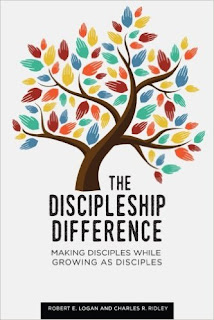 The Discipleship Difference begins with a pastor "carrying on a one-sided conversation in his head as he cleaned up the classroom:
The Discipleship Difference begins with a pastor "carrying on a one-sided conversation in his head as he cleaned up the classroom:I'm getting people through these classes, but nothing really comes of it. They are more knowledgeable, maybe, but...[i]t's not changing their lives. This is supposed to be discipleship. I might be seeing more educated disciples, but I'm not seeing better disciples. And I'm certainly not seeing more disciples. Where's the transformation?"Robert Logan and Charles Ridley spend the rest of the book describing discipleship programs that produce transformed lives and more disciples.
By way of disclaimer, I would note that I received a review copy of The Discipleship Difference and have worked with Bob Logan for about ten years.
The strength of The Discipleship Difference is in the big picture overview of a complete discipling program. Aimed primarily at pastors and other church leaders, the book engages with foundational questions and issues that are necessary to address before any concrete steps can be taken. Chapter 2, What Does a Disciple Look Like?, for example, lifts up the issue of what, exactly, it means to be a disciple. The chapter provides one comprehensive model for describing discipleship while also giving advise on how a church could develop its own. Chapter 3 lays out one of the book's major emphases, that discipleship starts in the harvest. We grow disciples not in the safety of the church classroom but out in the world, and we can begin the discipling process with people before their conversion. Other chapters look at topics such as the kinds of groups that support discipleship growth, how to help individuals grow as disciples based on their own gifts and personality, and how discipleship programs feed into the work of the congregation. Chapter 9 contains a variety of specific tools used in discipling others, and how they can be best applied.
Throughout the book, the chapters are tied together by the story of Pastor Rob as he struggles to implement the principles presented. While scriptural citations are woven throughout the text, more information about the social scientific basis of the work is described in occasional boxes titled, "If You Care About the Research -- A Note From Chuck." Outside resources are noted in a couple of places, and the book ends with a series of discussion questions for each chapter.
While the book does a good job of providing enough guidance in a variety of areas for a church to develop the necessary discipling structures for the people it is serving, the real value of The Discipleship Difference comes in the challenge it offers struggling churches and pastors. Logan and Ridley provide a clear vision of a way that meaningful, transformational discipleship can be achieved within a congregation. This vision is a shot of hope for declining churches. Yet that hope comes with the troubling awareness of all the ways that most of our congregations are not set up to do this discipling work. As Pastor Rob struggles, so many of us can imagine the struggles of building new models of discipleship into our current church context.
I would highly recommend The Discipleship Difference to pastors, church leaders, and others who want to think about how we begin to do the basic work Jesus called us to do. This book would be an especially good resource to study in clergy groups, where church leaders can discuss the ideas presented and support one another on implementing them.
Robert Logan is a church planter, coach, and author. He earned a DMin from Fuller Theological Seminary and writes an excellent blog, Logan Leadership, on church leadership, church growth, evangelism, and church planting. Charles Ridley developed the Church Planter Profile and is a licensed psychologist and professor at Texas A & M University with a PhD in Counseling Psychology from the University of Minnesota.

